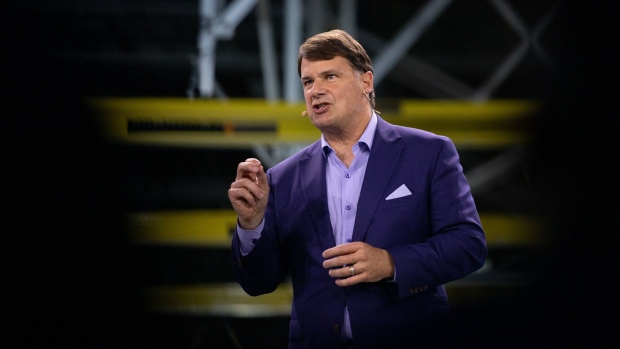Feb 15, 2024
Ford CEO Says Once-Good Relationship With UAW Altered by Strike
, Bloomberg News

(Bloomberg) -- Ford Motor Co.’s relationship with the United Auto Workers union, once a point of pride, was damaged by last fall’s strike and that could affect where it builds future electric vehicles.
Chief Executive Officer Jim Farley said the UAW’s decision to walk out at Ford’s Kentucky truck plant in October altered a relationship that had been built over decades. The six-week strike, the first nationwide walkout Ford had faced since 1976, ended with the union winning a 33% wage increase.
“We were the first truck plant they shut down and that was a moment for us,” Farley said Thursday at the Wolfe Automotive Conference in New York. “Clearly, our relationship has changed — it’s been a watershed moment for the company. Does it have business impact? Yes.”
UAW President Shawn Fain countered with a statement criticizing Farley.
“This contract was a major victory for working families across this country, and if Ford is upset about that, that tells you a lot about the leadership of this company,” Fain said. “Maybe Ford doesn’t need to move factories to find the cheapest labor on earth, maybe it needs to recommit to American workers and find a CEO who’s interested in the future of this country’s auto industry.”
Ford has the highest labor costs among the Detroit Three automakers, employing 57,000 UAW-represented workers, thousands more than General Motors Co. or Chrysler parent Stellantis NV. Ford had seen that as “the right kind of cost,” Farley said, because it bought the company labor peace.
But the new UAW contract will add $900 to the cost of each car Ford makes — more than the $575-a-car cost GM sees from the labor deal — and that will have an impact on how Ford expands its manufacturing footprint to accommodate growth in EVs and traditional internal-combustion-engine vehicles.
“As we look at this EV transition and ICE lasting longer and our truck business being more profitable, you know, we have to think carefully about our footprint,” Farley said, adding that the UAW strike “was an extremely difficult moment for the company. Ford had always prided itself on not having a strike since the ’70s.”
Farley reiterated comments from a Ford executive Wednesday that low-priced Chinese EVs represent a major competitive threat that will eventually arrive on US shores.
“If you cannot compete fair and square with the Chinese around the world, then 20% to 30% of your revenue is at risk,” Farley said. “As the CEO of a company that had trouble competing with the Japanese and the South Koreans, we have to fix this problem.”
That’s why Ford is now focusing on developing inexpensive, small EVs, which Farley believes will help overcome mainstream buyers’ objection to the high prices of battery-powered models.
Ford’s affordable, small EVs will hit the market “in a couple years,” John Lawler, chief financial officer, said on Bloomberg TV Thursday.
“It’s going to be a big inflection point for the industry when more affordable EVs come online,” Lawler said. “We have a small team working on that to change the way we do things and actually provide us significant breakthroughs.”
Ford now intends to sell EVs at the same price as gas-electric hybrids, which are priced $3,000 to $5,000 above traditional internal-combustion vehicles, Farley said.
“We have decided pretty quickly to bet on smaller EV platforms,” Farley said. “Since the middle of last year, we have assumed that we have to basically sell an EV at a hybrid premium — there is no more money for customers than that.”
(Updates with UAW president’s response from the fourth paragraph.)
©2024 Bloomberg L.P.


